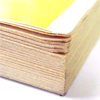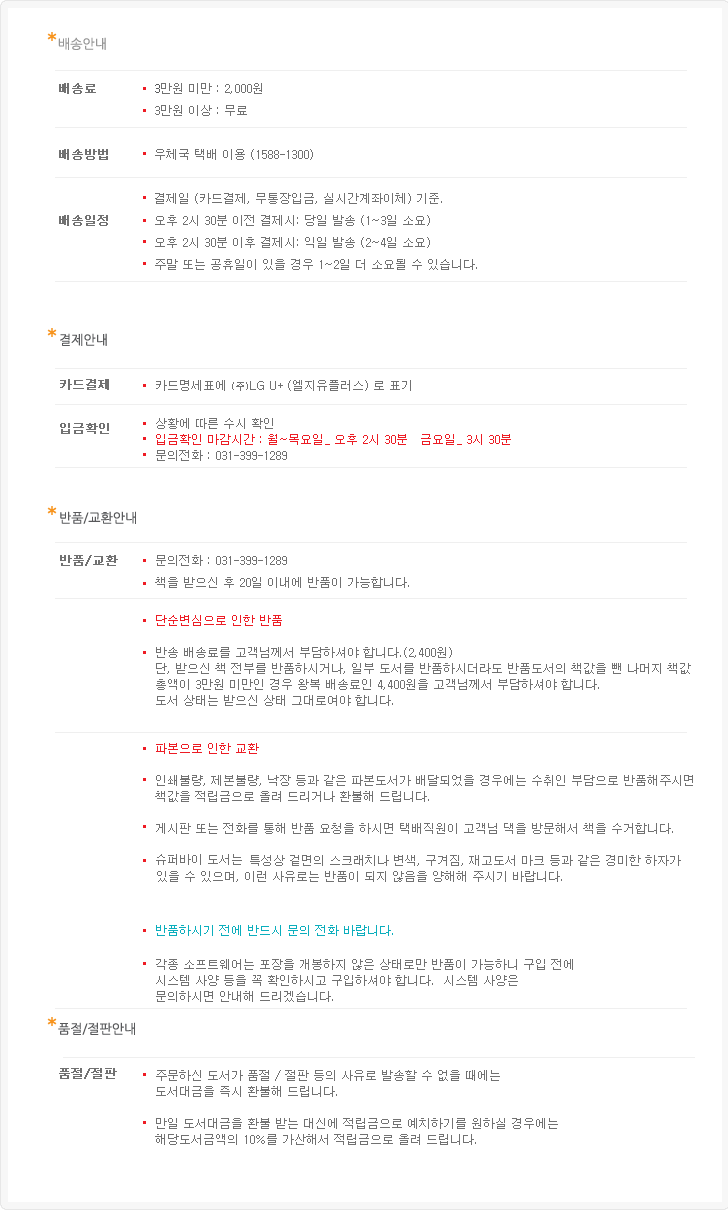|
|
|
|
|
|
|

| 최근 이 책을 구매하신 다른 회원의 책장 |
|
 |
|
|
|
[ 책 소개 ]
* Outstanding Science Trade Books for Children, National Science Teachers Association
이 책의 저자인 Chris Van Allsburg는 Jumanji, The Polar Express, The Garden of Abdul Gasazi로 3차례 Caldecott상을 받았으며, 현존하는 최고의 그림책 작가 중 한 명으로 추앙받고 있습니다. 주로 모노톤의 세밀화로 그려진 그의 그림책들은 독자들에게 보는 즐거움과 함께 지적인 만족감을 주는 흥미진진한 내용들로 구성되어 있습니다.
월터는 환경에 대해서는 별 관심이 없는 평범한 소년입니다. 도너츠를 포장했던 종이는 길거리 아무데나 버리고, 옆집에 사는 로즈가 생일선물로 심은 나무를 정성껏 가꾸는 것을 보고는 자기는 절대로 나무따위는 생일선물로 받지 않을 거라고 생각합니다. 쓰레기를 버릴 때도 분리 수거를 하지 않고 재활용품까지 쓰레기통에 몽땅 쏟아 버립니다. 저녁에 월터는 TV에서 보여주는 미래 세계, 즉 집집마다 자가용 비행기를 몰고 다니고, 버튼만 누르면 먹고 싶은 것을 기계가 만들어주는 미래의 모습이 멋지다고 생각합니다. 그리고 잠자리에 들면서 자기도 이런 멋진 미래세계에 살고 싶다고 생각합니다.
그리고 월터는 잠을 자면서 자신이 미래 세계에 와있는 꿈을 꿉니다. 그런데 미래세계는 월터가 생각했던 것과는 전혀 다른 모습이네요.
온 세상은 냄새나는 쓰레기 더미로 덮여 있고, 나무는 모두 베어지고 있으며, 공장에서 나오는 매연이 대기를 꽉 채우고 있고, 에베레스트산 꼭대기까지 호텔이 들어서 있는가 하면, 바다에는 치어까지 싹슬이를 하는 바람에 물고기를 발견하기 조차 어려웠습니다. 그리고 시내는 수많은 자동차들로 꽉 막혀 있어서 온갖 매연과 함께 차들이 울려대는 시끄러운 소음때문에 월터는 두 귀를 막아 버리고 말았습니다.
잠에서 깨어난 월터는 꿈 속에서 본 미래가 얼마나 끔찍한지, 그리고 그런 미래를 자신이 만들고 있다는 것을 깨닫게 됩니다. 그리고 이런 비참한 미래를 방지하기 위해서 스스로 무엇을 해야 하는지를 알게 됩니다...
고급스러운 아트지에 인쇄된 큰 사이즈의 | 닫기x |  What is 페이퍼백? What is 페이퍼백?
표지가 두꺼운 판지나 보드지가 아닌 비교적 얇은 종이를 사용해서 만든 책이며, 실박음질 대신에 풀로 제본처리하는 경우가 많습니다. 일반적으로 하드커버나 보드북에 비해서 가격이 저렴합니다. 소프트커버로 불리우기도 합니다. 책의 이음새 부분이 접히거나 휘는 내구성이 그리 좋지는 않은 책입니다.
|
[ 서지 정보 ]
Paperback: 48 pages
ISBN-10: 0547520263
ISBN-13: 978-0547520261
책 크기: 28.4 cm x 21.8 cm
[ 영문 서평 ]
Book Description
When it comes to the environment, young Walter is not an enlightened individual. He's a litterbug who believes sorting trash is a big waste of time. What's more, he thinks his friend's birthday present, a tree, is the most ridiculous gift he's ever seen.
Walter believes the future is going to be wonderful, filled with robots and other amazing inventions. One night while lying in bed, Walter wishes he could visit the future. He falls asleep and his wish comes true. But the world Walter sees is not exactly what he'd imagined. When he returns to the present, he is changed and so are his dreams.
Caldecott-winning artist Chris Van Allsburg brings us a striking look, in unique and evocative pictures, at what our future may hold.
Publishers Weekly
Two-time Caldecott Medalist Van Allsburg reaches a new pinnacle of excellence in both illustration and storytelling in his latest work. Since his first book, The Garden of Abdul Gasazi, appeared just over a decade ago, he has spun many strange and fantastic modern fairy tales, all of which spill over the edge of reality into magnificent dreamscapes. Here Van Allsburg introduces Walter, a boy who imagines the future as a marvelous time, with tiny airplanes that can be parked on the roof of your house and robots that take care of all your work for you. In the present, however, Walter is a litterbug who can't be bothered to sort the trash for recycling and laughs at Rose, the girl next door, because she receives a sapling for her birthday. One night, when Walter goes to sleep, his bed travels to the future. But he finds neither tiny airplanes nor robots, only piles of trash covering the street where he used to live, acres and acres of stumps where forests used to stand, rows and rows of great smokestacks belching out acrid smoke, and many other environmental nightmares. Van Allsburg renders each of these chilling scenarios in elaborate, superbly executed two-page spreads that echo the best work of M. C. Escher and Winsor McKay (creator of the Little Nemo comic strips). Walter and his bed land right in the middle of the action in each of these hallucinatory paintings, heightening the visual impact and forcing a hard look at the devastation surrounding Van Allsburg's protagonist. An awakened Walter, jolted by his dream, changes his ways: he begins to sort the trash and, like Rose, plants a tree for his birthday. Then his bed takes him to a different future, one where people tend their lawns with powerless mowers and where the trees he and Rose have planted stand tall and strong beneath a blue sky. Not only are Just a Dream 's illustrations some of the most striking Van Allsburg has ever created, but the text is his best yet. Van Allsburg has sacrificed none of the powerful, otherworldly spirit that suffuses his earlier works, and he has taken a step forward by bringing this spirit to bear on a vitally important issue. His fable builds to an urgent plea for action as it sends a rousing message of hope.
School Library Journal
Walter, an environmental ignoramus of a 10 year old, is careless or scornful of such elementary actions as recycling or tree planting. One nightmarish evening, however, he visits a future where his daydreams of technological paradise are demolished. Instead, there is merely a horrifically exacerbated continuation of today's eco-problems: landfills, expressways, smog, lifeless oceans, and vanished wilderness. Walter awakens reformed, and is rewarded with another dream: the future redeemed. As the story exhibits Van Allsburg's "signature" character (a child free of adult supervision) and plot (the dream-vision), so the pictures display the hallmarks of the artist's style: bird's- and worm's-eye perspectives, dramatic lighting effects, some geometric simplification of forms. Wordless double-page spreads alternate with pages of text and small vignettes. The abstract beauty of the images produces a curious tension with the idea of a barren and ugly future; the stylized orderliness of the art is itself eerily disturbing. That this depicts the nightmare of a child may excuse some inconsistencies (in an utterly ruined environment would trees still be cut down for toothpicks?), but the real disappointment comes at the end. Walter's utopian vision is an unchildlike nostalgia trip: a suburban reprise of the '40s. Such a sentimental and parochially narrow vision of a future for a privileged few is the chief failure of this well-meaning effort. |
|
|
|
|
 |
제품상제정보 배송/반품/교환 안내 |
|
|
|
Super Buy 도서는 미국 출판사의 재고도서(Remainder Book), 초과출간도서(Excess Inventory), 할인도서(Bargain Books)
등을 직수입해서 정가의 55%~80%를 할인한 가격에 판매하는 제품입니다.
Super Buy 책의 품질은 거의 새 책과 같은
수준이지만, 간혹 커버의 스크래치나 접힘과 같은 하자나, 책 하단의 재고도서 마크가 있을 수 있습니다.
저렴하게 판매하는 Super Buy 제품의 특성상 반품이 되지 않습니다만, 파본인 경우에는 착불로 반품하시면 책값을
환불해드리거나 적립금으로 올려드립니다. (반품 전에 연락 요망)
하프프라이스북에서는 중고도서(second hand book)를 취급하지 않습니다.
|
|
|
 - 등록된 128,146건의 서평이 있습니다. - 등록된 128,146건의 서평이 있습니다.
| 더보기 
|
|
|
|
|
|
|
 |
|
|
|
|
|
|